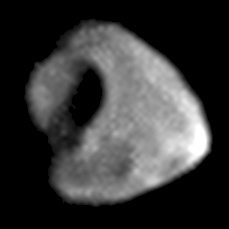Thebe (moon) facts for kids

|
|
| Discovery | |
|---|---|
| Discovered by | Stephen P. Synnott / Voyager 1 |
| Discovery date | March 5, 1979 |
| Orbital characteristics | |
| Periapsis | 218,000 km |
| Apoapsis | 226,000 km |
|
Mean orbit radius
|
221889.0 ± 0.6 km (3.11 RJ) |
| Eccentricity | 0.0175 ± 0.0004 |
| 0.674536 ± 0.000001 d (16 h 11.3 min) | |
|
Average orbital speed
|
23.923 km/s |
| Inclination | 1.076 ±0.003° (to Jupiter's equator) |
| Satellite of | Jupiter |
| Physical characteristics | |
| Dimensions | 116×98×84 km |
|
Mean radius
|
49.3 ± 2.0 km |
| Volume | ~500,000 km³ |
| Mass | 4.3×1017 kg |
|
Mean density
|
0.86 g/cm³ (assumed) |
| ~0.020 m/s² (0.004 g) | |
| ~0.040 km/s | |
| synchronous | |
| zero | |
| Albedo | 0.047 ± 0.003 |
| Temperature | ~124 K |
Thebe (also called Jupiter XIV) is the fourth closest moon to Jupiter. It's one of Jupiter's many natural satellites.
This moon was first spotted by Stephen P. Synnott. He found it in pictures taken by the Voyager 1 space probe. The discovery happened on March 5, 1979. At first, it was just called S/1979 J 2. Later, scientists found it in even older pictures from February 27, 1979. In 1983, it got its official name, Thebe. This name comes from a nymph in Greek myths. The mythological Thebe was the daughter of the river god Asopus and a lover of Zeus. Zeus is the Greek god similar to the Roman god Jupiter.
Contents
Thebe's Journey Around Jupiter
Thebe is the farthest of Jupiter's four inner moons. These moons orbit very close to the giant planet. Thebe travels around Jupiter at about 222,000 km away. This distance is about 3.11 times Jupiter's own radius.
Thebe's path around Jupiter is not a perfect circle. It's a bit stretched out, which scientists call an orbital eccentricity. Its orbit is also slightly tilted compared to Jupiter's middle, or equator. This tilt is unusual for a moon so close to its planet. Scientists think this is because of Io, another one of Jupiter's moons. In the past, Io's gravity might have pulled on Thebe. This pulling could have made Thebe's orbit more stretched and tilted over time.
What Thebe Looks Like
Thebe is not shaped like a perfect sphere (a ball). It's more like a lumpy potato. Its size is roughly 116 by 98 by 84 km. We don't know its exact weight or how dense it is. But if it's like another moon called Amalthea, it might weigh around 4.3 with 17 zeroes after it, in kg.
The surface of Thebe is quite dark. It also appears to have a reddish color.
Exploring Thebe
As mentioned, Voyager 1 first found Thebe. But not much was known about it until the Galileo spacecraft arrived at Jupiter. Galileo took many pictures of Thebe's surface. These pictures helped scientists learn more about what the moon is made of.
Images for kids
See also
 In Spanish: Tebe (satélite) para niños
In Spanish: Tebe (satélite) para niños


